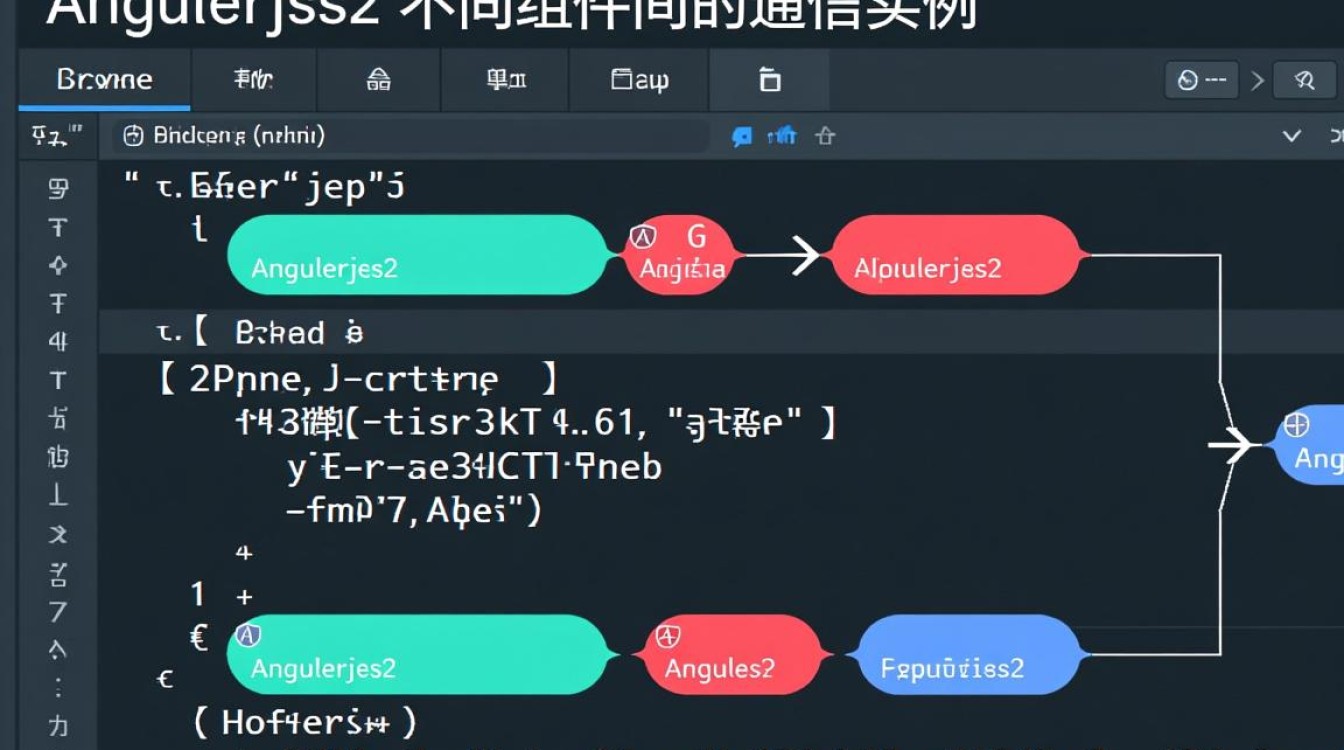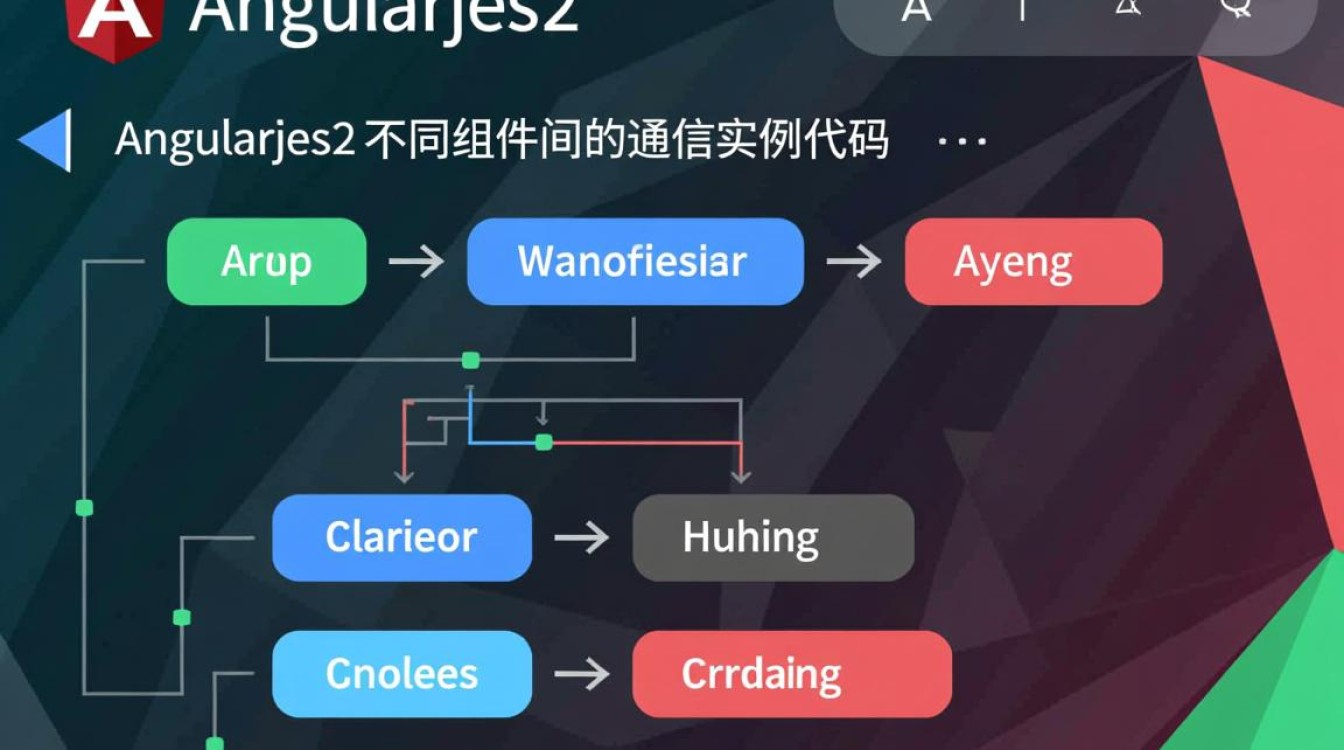Angularjs2不同组件间的通信实例代码
在Angularjs2(现称为Angular)应用开发中,组件间的通信是构建复杂应用的核心技能,不同组件可能需要共享数据、触发事件或协同工作,因此掌握多种通信方式至关重要,本文将通过实例代码详细介绍Angular中组件间通信的常见方法,包括父子组件通信、兄弟组件通信、跨级组件通信以及通过服务进行通信,帮助开发者理解并灵活应用这些技术。

父子组件通信
父子组件是Angular中最常见的组件关系,通信方式主要包括通过@Input()和@Output()实现数据传递和事件触发。
父组件向子组件传递数据(@Input)
父组件通过属性绑定将数据传递给子组件,子组件使用@Input()装饰器接收数据。
子组件代码(child.component.ts):
import { Component, Input } from '@angular/core';
@Component({
selector: 'app-child',
template: `<p>接收到的数据:{{ childData }}</p>`
})
export class ChildComponent {
@Input() childData: string; // 接收父组件传递的数据
}父组件代码(parent.component.ts):
import { Component } from '@angular/core';
@Component({
selector: 'app-parent',
template: `
<app-child [childData]="parentMessage"></app-child>
<input [(ngModel)]="parentMessage" placeholder="输入消息">
`
})
export class ParentComponent {
parentMessage = '来自父组件的消息';
}子组件向父组件传递数据(@Output)
子组件通过@Output()和EventEmitter向父组件触发事件,父组件监听事件并处理数据。
子组件代码(child.component.ts):
import { Component, Output, EventEmitter } from '@angular/core';
@Component({
selector: 'app-child',
template: `
<button (click)="sendMessage()">发送消息</button>
`
})
export class ChildComponent {
@Output() messageEvent = new EventEmitter<string>(); // 定义事件发射器
sendMessage() {
this.messageEvent.emit('来自子组件的消息'); // 触发事件并传递数据
}
}父组件代码(parent.component.ts):
import { Component } from '@angular/core';
@Component({
selector: 'app-parent',
template: `
<app-child (messageEvent)="receiveMessage($event)"></app-child>
<p>接收到的消息:{{ receivedMessage }}</p>
`
})
export class ParentComponent {
receivedMessage: string;
receiveMessage(message: string) {
this.receivedMessage = message; // 处理子组件传递的消息
}
}兄弟组件通信
兄弟组件之间无法直接通信,通常通过共享父组件或使用服务来实现。
通过共享父组件通信
父组件作为中介,接收一个子组件的数据,再传递给另一个子组件。

父组件代码(parent.component.ts):
import { Component } from '@angular/core';
@Component({
selector: 'app-parent',
template: `
<app-child-a (messageEvent)="receiveMessage($event)"></app-child-a>
<app-child-b [message]="receivedMessage"></app-child-b>
`
})
export class ParentComponent {
receivedMessage: string;
receiveMessage(message: string) {
this.receivedMessage = message;
}
}子组件A代码(child-a.component.ts):
import { Component, Output, EventEmitter } from '@angular/core';
@Component({
selector: 'app-child-a',
template: `<button (click)="sendMessage()">发送消息</button>`
})
export class ChildAComponent {
@Output() messageEvent = new EventEmitter<string>();
sendMessage() {
this.messageEvent.emit('来自子组件A的消息');
}
}子组件B代码(child-b.component.ts):
import { Component, Input } from '@angular/core';
@Component({
selector: 'app-child-b',
template: `<p>接收到的消息:{{ message }}</p>`
})
export class ChildBComponent {
@Input() message: string;
}通过服务通信
使用可注入的服务和BehaviorSubject实现兄弟组件间的数据共享。
服务代码(shared.service.ts):
import { Injectable } from '@angular/core';
import { BehaviorSubject } from 'rxjs';
@Injectable({
providedIn: 'root' // 全局单例服务
})
export class SharedService {
private messageSource = new BehaviorSubject<string>('默认消息');
currentMessage = this.messageSource.asObservable();
changeMessage(message: string) {
this.messageSource.next(message);
}
}子组件A代码(child-a.component.ts):
import { Component } from '@angular/core';
import { SharedService } from './shared.service';
@Component({
selector: 'app-child-a',
template: `<button (click)="sendMessage()">发送消息</button>`
})
export class ChildAComponent {
constructor(private sharedService: SharedService) {}
sendMessage() {
this.sharedService.changeMessage('来自子组件A的消息');
}
}子组件B代码(child-b.component.ts):
import { Component, OnInit } from '@angular/core';
import { SharedService } from './shared.service';
@Component({
selector: 'app-child-b',
template: `<p>接收到的消息:{{ message }}</p>`
})
export class ChildBComponent implements OnInit {
message: string;
constructor(private sharedService: SharedService) {}
ngOnInit() {
this.sharedService.currentMessage.subscribe(msg => {
this.message = msg;
});
}
}跨级组件通信
跨级组件(如祖组件与孙组件)可以通过@Input()逐级传递数据,或使用服务实现直接通信。
逐级传递数据
祖组件代码(grandparent.component.ts):

import { Component } from '@angular/core';
@Component({
selector: 'app-grandparent',
template: `
<app-parent [data]="grandparentData"></app-parent>
<input [(ngModel)]="grandparentData" placeholder="输入数据">
`
})
export class GrandparentComponent {
grandparentData = '来自祖组件的数据';
}父组件代码(parent.component.ts):
import { Component, Input } from '@angular/core';
@Component({
selector: 'app-parent',
template: `<app-child [data]="data"></app-child>`
})
export class ParentComponent {
@Input() data: string;
}子组件代码(child.component.ts):
import { Component, Input } from '@angular/core';
@Component({
selector: 'app-child',
template: `<p>接收到的数据:{{ data }}</p>`
})
export class ChildComponent {
@Input() data: string;
}通过服务通信
跨级组件可以直接通过共享服务通信,无需逐级传递数据。
服务代码(shared.service.ts):
import { Injectable } from '@angular/core';
import { BehaviorSubject } from 'rxjs';
@Injectable({
providedIn: 'root'
})
export class SharedService {
private data = new BehaviorSubject<string>('默认数据');
data$ = this.data.asObservable();
updateData(value: string) {
this.data.next(value);
}
}祖组件代码(grandparent.component.ts):
import { Component } from '@angular/core';
import { SharedService } from './shared.service';
@Component({
selector: 'app-grandparent',
template: `
<button (click)="updateData()">更新数据</button>
<app-child></app-child>
`
})
export class GrandparentComponent {
constructor(private sharedService: SharedService) {}
updateData() {
this.sharedService.updateData('来自祖组件的新数据');
}
}子组件代码(child.component.ts):
import { Component, OnInit } from '@angular/core';
import { SharedService } from './shared.service';
@Component({
selector: 'app-child',
template: `<p>接收到的数据:{{ data }}</p>`
})
export class ChildComponent implements OnInit {
data: string;
constructor(private sharedService: SharedService) {}
ngOnInit() {
this.sharedService.data$.subscribe(value => {
this.data = value;
});
}
}Angular提供了多种组件间通信的方式,开发者可以根据实际需求选择合适的方法:
| 通信方式 | 适用场景 | 优点 | 缺点 |
|---|---|---|---|
| @Input/@Output | 父子组件通信 | 简单直接,无需额外依赖 | 跨级通信需逐层传递 |
| 共享服务 | 兄弟组件或跨级组件通信 | 解耦性强,数据实时同步 | 需要管理服务实例 |
| ViewChild | 父组件直接调用子组件方法 | 适用于复杂交互 | 紧耦合,灵活性较低 |
| BehaviorSubject | 需要响应式数据流时 | 支持多订阅,数据实时更新 | 需要熟悉RxJS操作符 |
通过合理选择通信方式,可以构建出结构清晰、易于维护的Angular应用,开发者应结合项目需求,灵活运用上述技术,确保组件间的高效协作。
图片来源于AI模型,如侵权请联系管理员。作者:酷小编,如若转载,请注明出处:https://www.kufanyun.com/ask/57056.html




